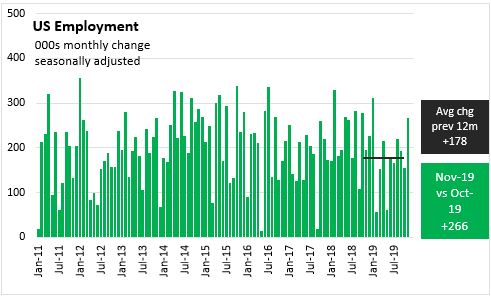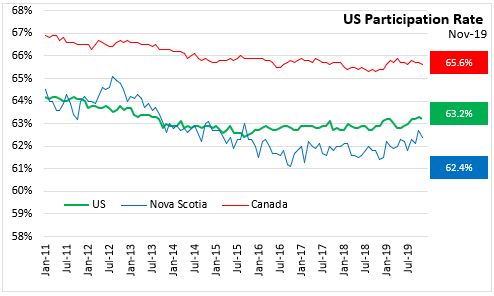The Economics and Statistics Division maintains archives of previous publications for accountability purposes, but makes no updates to keep these documents current with the latest data revisions from Statistics Canada. As a result, information in older documents may not be accurate. Please exercise caution when referring to older documents. For the latest information and historical data, please contact the individual listed to the right.
<--- Return to Archive
For additional information relating to this article, please contact:
December 06, 2019US EMPLOYMENT, NOVEMBER 2019 The US Bureau of Labor Statistics reports today that US non-farm payroll employment increased by 266,000 in November. The monthly increase was faster than the average of 178,000 over the previous twelve months as employment growth slowed in 2019. Results for October and September were revised upward to show an additional gain of 41,000 jobs over these two months.
US employment gains in the last month were notable in health care (+45,000), professional and technical services (+31,000), manufacturing (+54,000, reflecting the return of auto workers after a strike in September and October), leisure and hospitality (+45,000), transportation and warehousing (+16,000) and financial activities (+13,000). Employment in retail and wholesale trade, construction, information, and government showed little change on the month, while mining employment declined.

The US unemployment rate declined 0.1 percentage points in November to 3.5 per cent. US unemployment continues to be at a historically low level. Unemployment rates across most advanced economies (including Canada and Nova Scotia) are at levels below long run averages.

The US participation rate was down 0.1 percentage points to 63.2 per cent in November. Unlike unemployment rates, the US participation rate has failed to return to pre-recession levels and has only increased modestly since bottoming out in 2015, with fluctuations around a narrow range since the start of 2016. Participation rates in Canada and Nova Scotia also declined in the years after the global financial crises. Canada and Nova Scotia participation rates have increased in 2019 compared to the end of 2018.

The US employment to population ratio was unchanged at 61.0 per cent in November. The US employment rate has maintained a gradual upward trend since the middle of 2013.
Employment rates in Canada trended up in 2016 and 2017 but remained below levels observed in 2008. Since the summer of 2018, the national employment rate re-established an upward trend, but has fallen since May 2019. With an aging population and declining labour supply, Nova Scotia's employment rates trended down over the 2012 to 2016 period. Nova Scotia's employment rate was elevated in the first half of 2019 before falling in July. In November, the Nova Scotia employment rate was 57.5 per cent.

Note: Canadian and US labour force statistics refer to different working-age cohorts.
Source: US Bureau of Labor Statistics, Statistics Canada Table 14-10-0287-02
<--- Return to Archive